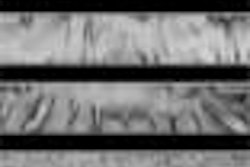One of the first large virtual colonoscopy studies to be performed entirely in a screening population yielded lower-than-expected sensitivity for the detection of colorectal lesions, as compared to the results of conventional colonoscopy performed on the same day.
Although the study was apparently designed and executed with care, virtual colonoscopy technology and techniques have advanced in important ways since it was performed (1998-2001), casting doubt on the validity of the results compared to the state of the art today. Still, virtual colonoscopy researchers will need to demonstrate that advanced techniques can produce reliable results in a large, low-prevalence population.
The study of 703 asymptomatic patients examined adults at moderately elevated risk of colorectal polyps and cancer. As virtual colon screening with CT moves toward the mainstream, such patients are considered among the likeliest candidates to choose it as a less-invasive alternative for colorectal cancer screening.
Screening a screening population
"Several promising reports of the performance of CT colonography have been published in the literature," wrote Dr. C. Daniel Johnson, Dr. William Harmsen, Dr. Lynn Wilson and colleagues in the August issue of Gastroenterology. "However, most of these have been based on selected patient groups with high lesion prevalence, such as symptomatic patients or those with known or suspected colorectal neoplasms. Because of selection bias, it may not be appropriate to extrapolate such early outcomes to the screening setting" (Gastroenterology, August 2003, Vol. 125:2, pp. 311-319).
The researchers at the Mayo Clinic in Rochester, MN, sought to estimate the sensitivity, specificity, and interobserver agreement of virtual colonoscopy for the detection of colorectal polyps in a low-prevalence population, and to compare such estimates with colonoscopy as the gold standard.
All 703 subjects were aged 50 or older (442 men and 661 women, mean age 64), and were considered to be at higher-than-average risk of colorectal neoplasm due to a personal history of neoplasia (72.6%), family history (excluding those with known familial polyposis) (25.4%), or new-onset asymptomatic iron deficiency (2.0%), the authors wrote. The prevalence of clinically significant lesions (1 cm and larger) was 5%.
Technique
Prior to same-day virtual and conventional colonoscopy, the subjects underwent standard bowel cleansing with either Golytely oral lavage and bisacodyl laxative tablets (n=681) magnesium citrate and bisacodyl (n=4) or Phopho-Soda (n=18). Most patients (90%) also received glucagon antispasmodic prior to manual insufflation of the colon with CO2, to patient tolerance.
CT images of the entire bowel were acquired using either a single-slice HiSpeed Advantage scanner (16%, n=120) or a four-detector LightSpeed (83%, n=583) (GE Medical Systems, Waukesha, WI).
After scout images were obtained to assess luminal distension, single-detector CT images were acquired with 3-4 20-second breathholds, and a 3-second acquisition overlap between breathholds. Collimation was set at 5-mm collimation, table speed at 6.5 mm/s, pitch at 1.6, with 70 mAs, 512 x 512 matrix, 120 kVp, and 3-mm reconstruction intervals.
Alternatively, multislice CT images were acquired at 4 x 5 mm collimation, pitch 15 mm/s, 80 mAs and 120 kVp, with a standard reconstruction algorithm. A well-tested internal software program was used for image review of axial images with 3-D viewing for problem-solving, the authors stated.
Double reading of each dataset was performed on a workstation by two of three experienced abdominal radiologists on the team, each of whom had performed at least 150 virtual colonoscopy studies before the present study. They were blinded to each other's results, and instructed to ignore lesions smaller than 5 mm. Results were reported for each reader and for both readers on each dataset.
Experienced staff gastroenterologists conducted conventional colonoscopy immediately after CT; 13 of 703 conventional studies were incomplete.
Results
The results of both exams showed a total of 153 polyps 5 mm or larger in 103 patients, including 94 polyps 5-9 mm in 69 patients, and 59 polyps larger than 1 cm in 47 patients. There were 3 carcinomas, all larger than 1 cm.
In a review of overall virtual exam quality, residual fluid in the colon was judged moderate in 88 patients and nondiagnostic in 4. Residual stool was moderate in 75 patients and nondiagnostic in 7. Colonic distension was judged suboptimal in at least 1 segment in 31% of patients, and 23 patients had a nondiagnostic CT exam due to one or more of these factors. These 23 patients had a total of 4 polyps, 1 larger than a centimeter, and the patients were included in the statistical analysis due to their small numbers. There were mild breathhold artifacts in 107 patients, and moderate artifacts in 8, the authors wrote.
"The sensitivity for the detection of polyps 5-9 mm was 35%, 29%, 57%, and 54% for readers 1, 2, 3, and double-reading, respectively," they stated. "For the detection of polyps > 1.0 cm, the sensitivity was 34%, 32%, 73%, and 63%.... Inter-reader agreement varied substantially.... The rectum accounted for the colon segment with the highest error rate, but this was not significantly higher than error rates in other colon segments. There was no significant association between missed detection and polyp location."
There was a borderline association for nonadenomatous polyps to be undetected more frequently than adenomatous polyps, the authors continued. "Lesion morphology was significantly associated with missed detection. The risk of missed detection was greater for both sessile polyps, P=0.02 ... and for flat polyps P=0.04 ... relative to pedunculated polyps."
Somewhat better than the per-polyp figures but still low were the per-patient results. Some radiologists consider per-patient sensitivity a valid measure of the virtual exam's efficacy because it means that the right patients would likely be selected for follow-up conventional colonoscopy in a normal screening environment.
"The sensitivity for detecting patients with at least 1 polyp 5-9 mm ranged from 41% to 69%, with a double-reading sensitivity of 65%..." the authors wrote. "Specificity for the same polyps ranged from 88% to 95%, with a double-reading specificity of 86%"
Less sensitive than expected
"CT colonography was less sensitive in detecting polyps than would have been predicted from earlier studies in cohorts with a higher prevalence of polyps...," the authors wrote.
Previous studies demonstrating higher sensitivities looked at populations with a higher prevalence of colorectal lesions. One study, by Fenlon et al, examined 100 patients who had positive flexible sigmoidoscopy and fecal occult blood tests. For the detection of clinically significant polyps, two radiologists achieved 91% and 96% specificity, respectively, in a population with 19% prevalence of clinically significant polyps (Radiology, February 1999, Vol. 210:2, pp. 423-428).
However, Fenlon’s group read the entire dataset axially and in 3-D endoluminal viewing, while the present study reserved 3-D viewing for problem-solving.
The Mayo Clinic's own study of very high-risk patients (67% had lesions 1 cm and larger) yielded sensitivity of 75% and specificity of 93% for clinically significant lesions (Radiology, September 2000, Vol. 216:3, pp. 704-711).
"The low frequency of polyp occurrence in the present study may have contributed to detection difficulties because of reader fatigue and data overload," Johnson and colleagues wrote. "The reading method employed in this study required the reader to examine a huge set of data (150 supine plus 150 prone images) for each patient."
The wide variation in polyp detection rates between observers (32% to 73%) was hard to explain, they wrote, since experience among the readers was similar and the radiologists met to enhance the uniformity of practice. Still, the high variability may be related to the study cohort, in which each missed polyp had a large effect on reader sensitivity, resulting in high interobserver variability.
"In contrast, very high specificities are based on much larger numbers and demonstrate excellent interobserver agreement," the authors wrote. "This latter fact is encouraging for CT colonography as a future highly competitive colorectal examination."
Continually improving display methods, and the assistance of computer-aided detection schemes, can be expected to correct most of the perceptual errors in the future, they wrote. Virtual colonoscopy also carries additional advantages, including an excellent safety record, high patient acceptance, and assessment of extracolonic abnormalities.
"Technologic refinements, such as computer-aided diagnosis, should be explored to minimize reading error," they concluded. "Specificities, based on large numbers, are high and exhibit excellent agreement among observers."
The state of the art
Commenting on the study, Dr. Abraham Dachman, professor of radiology at the University of Chicago, told AuntMinnie.com that the Mayo research was both well designed and well executed, and agreed with the authors that most errors were technical and perceptual in nature.
However, he said, a number of technical improvements have improved results significantly since the Mayo study was conducted between 1998 and 2001.
"The better results when multiple readers were used emphasizes the need for extensive experience in interpretation and highlights the value of ongoing research in computer-aided diagnosis as a 'second read' for (VC) studies," Dachman said. "CAD will likely be incorporated into several workstations in the next couple of years and (will) increase the confidence and accuracy of interpretation, even by novices."
In addition, the liquid lavage (PEG) used for bowel preparation in the study can leave residual fluid that can hide polyps, he continued, and in a non-research setting a so-called "dry prep" (phosphosoda or magnesium citrate) is routinely used. Thinner collimation (1-3 mm) would improve the quality of 3-D images for problem-solving over the 5-mm collimation used in the study, and the use of a multidetector scanner (used in 83% of patients, with 3-mm reconstruction interval) would eliminate the need for multiple breathholds and essentially eliminate respiratory motion artifact.
"Software for interpretation has improved significantly since then," Dachman said. "Our knowledge of pitfalls in interpretation (e.g. flat lesions, pseudotumors, bowel mobility) has improved since then, and it is likely that the same researchers would have better results reading the same cases today."
By Eric BarnesAuntMinnie.com staff writer
August 13, 2003
Related Reading
Virtual colonoscopy falls short in multicenter trial, June 3, 2002
Copyright © 2003 AuntMinnie.com



















